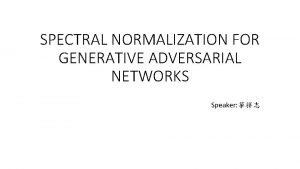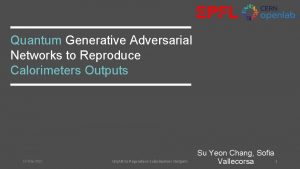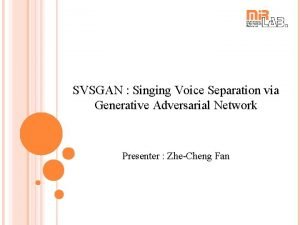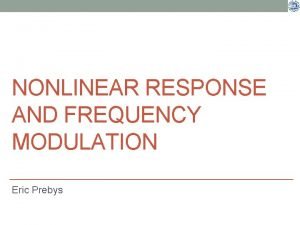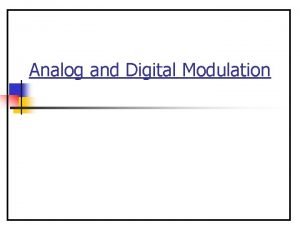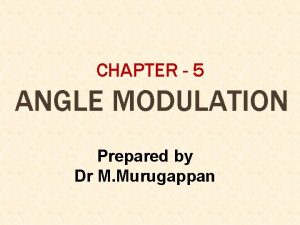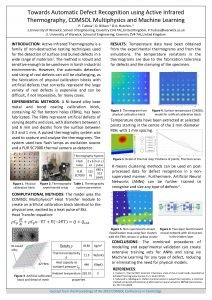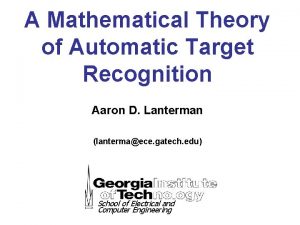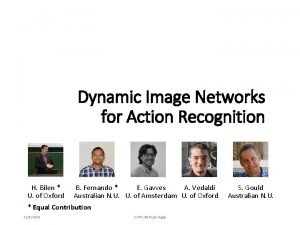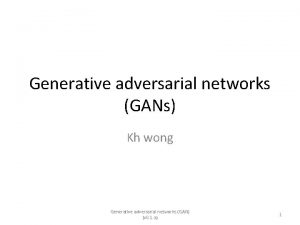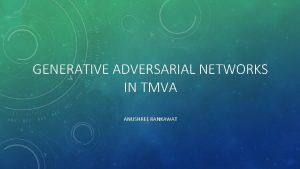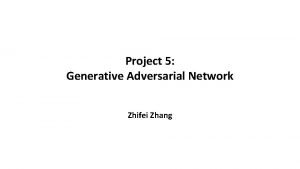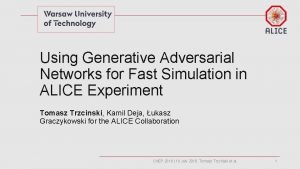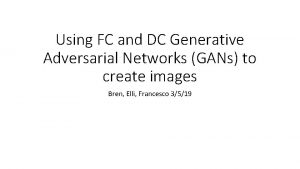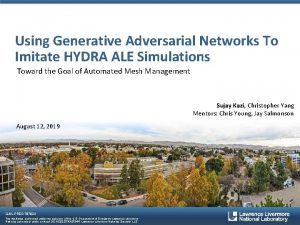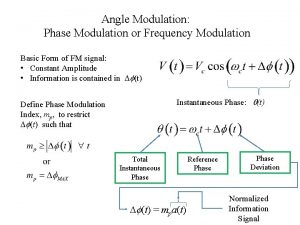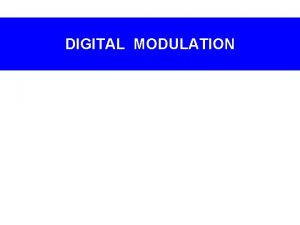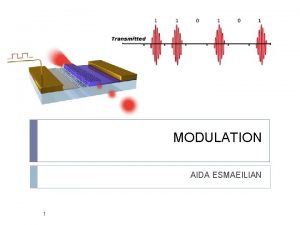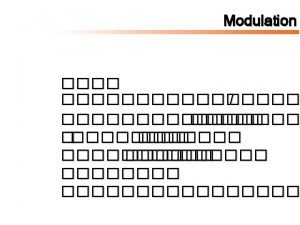Automatic Modulation Recognition Using Generative Adversarial Networks Group




![Literature Review • • GAN 2014, Goodfellow et al. Generative Adversarial Network(GAN)[5] 2014, Mirza Literature Review • • GAN 2014, Goodfellow et al. Generative Adversarial Network(GAN)[5] 2014, Mirza](https://slidetodoc.com/presentation_image_h2/a569cfe37fa794f9b7ff5c56838f4c5d/image-5.jpg)







![Reference • • • [1]: Azzouz, E. E. ; Nandi, A. K. Automatic Modulation Reference • • • [1]: Azzouz, E. E. ; Nandi, A. K. Automatic Modulation](https://slidetodoc.com/presentation_image_h2/a569cfe37fa794f9b7ff5c56838f4c5d/image-13.jpg)
- Slides: 13

Automatic Modulation Recognition Using Generative Adversarial Networks Group 4 Jiawei Yin, Jinglong Du, Ziwen Li

Background • In recent years, due to the increasing number of fixed spectrum allocation and wireless devices, spectrum resources become more and more scarce. • Spectrum sensing is a technique that help to allocate the limited resources • A key enabler in spectrum sensing is automatic modulation recognition(AMR)

Background • In the past, AMR is done by the manual work. To expand AMR technique into unfamiliar tasks and signals, Generative Adversarial Networks (GAN) is introduced to help do the modulation classification. • GAN plays a min-max game which includes a generator(G) and a discriminator(D).

Literature Review • AMR • 1996, Azzouz et al. “Automatic Modulation Recognition of Communication Signals. ”[1] • 2016, O’Shea et al. propose a method to apply CNN to the modulation recognition field[2] and use time-domain in-phase orthogonal (IQ) signal as the input of the network. • 2018, Li et al. Robust Automated VHF Modulation Recognition Based on Deep Convolutional Neural Networks. [3] • 2018, Bin et al. [4] successfully linked signal processing with computer vision by application of GAN.
![Literature Review GAN 2014 Goodfellow et al Generative Adversarial NetworkGAN5 2014 Mirza Literature Review • • GAN 2014, Goodfellow et al. Generative Adversarial Network(GAN)[5] 2014, Mirza](https://slidetodoc.com/presentation_image_h2/a569cfe37fa794f9b7ff5c56838f4c5d/image-5.jpg)
Literature Review • • GAN 2014, Goodfellow et al. Generative Adversarial Network(GAN)[5] 2014, Mirza et al. conditional generative adversarial network (CGAN)[6] 2016, Radford et al. Deep Convolutional Generative Adversarial Network (DCGAN)[7]

Dataset • A synthetic dataset consists of 11 modulations (8 digital and 3 analog) at varying signal-to-noise ratios, ranging from − 20 d. B to 20 d. B. * • Size: 110000*2*128(train input), 110000*1(train label) 110000*2*128(test input), 110000*1(test label) • Each modulation has 20000 examples * The dataset is available from: https: //www. deepsig. ai/datasets

Feature Extraction µ Input Encoder(E) Z Ɛ Encoder(E) Layer Type Input Shape Reshape 2*128 LSTM 128*2 Dense 100 Normal Distribution s exp

Model Construction Noise Input Feature Extraction Classifier(C) Data Input Encoder(E) z Fake samples Generator(G) Real samples Discrimator(D)

Model Construction Generator(G) Encoder(E) Classifier(C) Discriminator(D) Layer Type Input Shape Reshape 2*128 Dense 100 Reshape 2*128 LSTM 128*2 Reshape 8192 Conv 2 D 2*128*1 Dense 10 Conv 2 DTranspose 2*128*32 Average. Pooling 2 D 2*128*32 Dense 100 Conv 2 DTranspose 2*128*256 Conv 2 D 2*64*32 Custom Layer 100 Conv 2 DTranspose 2*128*80 Average. Pooling 2 D 2*64*32 Reshape 2*128*1 Flatten 2*32*32 Dense 2048

Current Results The loss of generator and discriminator is shown below. The learning rate is 0. 004 for C and 0. 001 for G and D. We use Adam as the optimizer for all the model. The loss function for G i is mean squared error, for C is sparse categorical crossentropy and for D is binary crossentropy.

Current Results evaluation The final classifier evaluation loss of 110000 test data is 7. 728.

Further Work ● Preprocess the data to get better result. ● Solve the coding problem to get the accuracy of our trained model. ● Compare our approach with other DL methods.
![Reference 1 Azzouz E E Nandi A K Automatic Modulation Reference • • • [1]: Azzouz, E. E. ; Nandi, A. K. Automatic Modulation](https://slidetodoc.com/presentation_image_h2/a569cfe37fa794f9b7ff5c56838f4c5d/image-13.jpg)
Reference • • • [1]: Azzouz, E. E. ; Nandi, A. K. Automatic Modulation Recognition of Communication Signals. IEEE Trans. Commun. 1996, 431– 436. • [4]: Tang, B. ; Tu, Y. ; Zhang, Z. ; Lin, Y. Digital Signal Modulation Classification With Data Augmentation Using Generative Adversarial Nets in Cognitive Radio Networks. IEEE Access 2018, 6, 15713– 15722. • [5]: Goodfellow, I. J. ; Pouget-Abadie, J. ; Mirza, M. ; Xu, B. ; Warde-Farley, D. ; Ozair, S. ; Courville, A. ; Bengio, Y. Generative Adversarial Networks. Adv. Neural Inf. Process. Syst. 2014, 3, 2672– 2680. • [6]: Mirza, M. ; Osindero, S. Conditional Generative Adversarial Nets. In Proceedings of the Neural Information Processing Systems (NIPS), Montreal, QC, Canada, 8– 13 December 2014. • [7]: Radford, A. ; Metz, L. ; Chintala, S. Unsupervised Representation Learning with Deep Convolutional Generative Adversarial Networks. In Proceedings of the International Conference on Learning Representations (ICLR), San Juan, PR, USA, 2– 4 May 2016. [2]: O’Shea, T. J. ; Hoydis, J. An Introduction to Deep Learning for the Physical Layer. IEEE Trans. Cognit. Commum. Netw. 2017, 3, 563– 575. [3]: Li, R. ; Li, L. ; Yang, S. ; Li, S. Robust Automated VHF Modulation Recognition Based on Deep Convolutional Neural Networks. IEEE Commun. Lett. 2018, 22, 946– 949.
 Spectral normalization for generative adversarial networks
Spectral normalization for generative adversarial networks Conditional generator
Conditional generator Unsupervised image to image translation
Unsupervised image to image translation Quantum generative adversarial learning
Quantum generative adversarial learning Generative adversarial network
Generative adversarial network Amplitude modulation vs frequency modulation
Amplitude modulation vs frequency modulation Amplitude modulation vs frequency modulation
Amplitude modulation vs frequency modulation Advantages of angle modulation
Advantages of angle modulation Automatic defect recognition
Automatic defect recognition Automatic target recognition
Automatic target recognition Convolutional neural networks for visual recognition
Convolutional neural networks for visual recognition Dynamic image networks for action recognition
Dynamic image networks for action recognition Datagram switching
Datagram switching Backbone networks in computer networks
Backbone networks in computer networks
